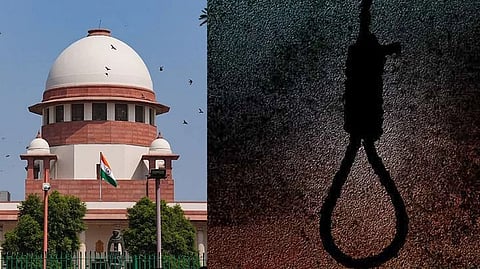

NEW DELHI: In what appears to be a revival of the debate surrounding capital punishment, the Supreme Court this week agreed for a fresh examination of the legality of the method employed i.e. death by hanging.
Four decades ago, the nation’s apex court upheld that the mode of executing death-row prisoners by hanging cannot be deemed too cruel or barbaric.
The SC’s review rests on two counts – one of them being the non-application of the test of proportionality in the 1983 judgement, and the second being the scientific advancements made in 40 years that warrants an inquiry into a less painful method of execution.
The apex court wants to analyse the impact of death by hanging, the suffering caused, the time taken, and more importantly, whether there is an alternative means more suited to upholding human dignity.
There are two critical judgments on the issue – one of them is Bachan Singh vs State of Punjab (1980), a judgement which upheld capital punishment, but restricted it to the rarest of rare cases.
The second case is Deen Dayal vs Union of India and others (1983), which argued that hanging was the least painful method of execution, compared to alternatives like electrocution, use of a gas chamber, and lethal injection.
Interestingly, the 35th Report of the Law Commission (1967) had considered the three alternatives as a relatively less painful procedure.
The conversation is timely as the Supreme Court recently commuted the 10-year-old death sentence of a man accused of kidnapping and murdering a seven-year-old child, to 20 years’ imprisonment without remission.
The SC bench argued that the convict was amenable to reform as he had obtained a diploma while in jail for the past 14 years.
The acquisition of a vocation while imprisoned has an important bearing on his ability to lead a gainful life, the bench felt.
But, the judicial and administrative perspectives have sided more towards supporting capital punishment. Last year, courts across India sentenced as many as 165 people to death, which was the highest in two decades. This list included 38 convicts named by an Ahmedabad court in the 2008 serial blasts episode. Many States in India have also broadened the scope of crimes punishable by capital punishment, while over 50% of the death sentences were on account of crimes of a sexual nature. In 2018, the penal code prescribed the death penalty for sexual assault of girls under the age of 12. Rapists of children were also being sentenced to death in the courts of Karnataka, MP, Rajasthan and Haryana. The sale or manufacturing of spurious liquor invites capital punishment in MP and Punjab.
What is also being seen is that the Supreme Court has over the years narrowed down the scope of applying capital punishment in judgments.
Following the 1980 judgement, the apex court and high courts have commuted several death sentences to life imprisonment.
Last year, over 40 prisoners who were among 68 sentenced to death, were acquitted by high courts.
Those in support of the death penalty argue that such mechanisms are a necessity, not just as a deterrent, but as a means of offering some closure to the kin of the victims.
However, it has also been observed that procedural shortcomings and flawed investigations risk endangering the life of an innocent man or woman.
More than anything, the death penalty is ‘an eye for an eye’ response to acts of crime, and a process that holds no place in civilised societies.
Visit news.dtnext.in to explore our interactive epaper!
Download the DT Next app for more exciting features!
Click here for iOS
Click here for Android